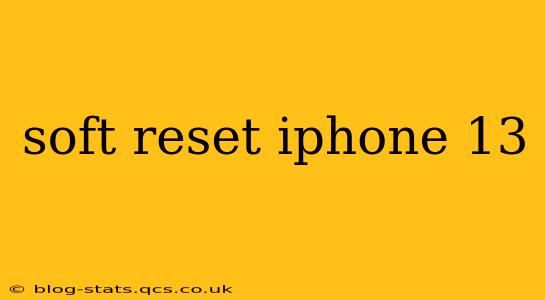The iPhone 13, like any sophisticated piece of technology, can sometimes experience minor glitches. A simple soft reset, also known as a force restart, can often resolve these issues without losing any data. This quick guide will walk you through the process and explain when a soft reset is the ideal solution.
What is a Soft Reset (Force Restart)?
A soft reset is a simple procedure that temporarily interrupts your iPhone's power cycle, clearing its memory and resolving minor software problems. It's different from a factory reset, which erases all your data and settings. Think of it as a quick reboot for your phone – a way to refresh the system without significant disruption.
How to Soft Reset Your iPhone 13
The method for forcing a restart on the iPhone 13 is slightly different than older models. Follow these steps precisely:
- Quickly press and release the Volume Up button.
- Quickly press and release the Volume Down button.
- Press and hold the Side button (the power button on the right side). Keep holding it until you see the Apple logo appear on the screen. This will take approximately 10-15 seconds.
That's it! Your iPhone 13 will now power off and then back on, effectively performing a soft reset.
When Should You Perform a Soft Reset?
A soft reset is a valuable troubleshooting step for a variety of minor issues, including:
- Frozen screen: If your screen is unresponsive or frozen, a soft reset can often resolve the problem.
- App crashes: If an app keeps crashing or freezing, restarting your phone can help clear any temporary glitches within the app or the operating system.
- Unresponsive buttons: If the buttons on your iPhone are not responding as expected, a soft reset is worth trying.
- Performance issues: If your phone is running slowly or experiencing lag, a soft reset can sometimes improve performance.
- Network connectivity problems: While not a guaranteed fix, a soft reset can sometimes help resolve issues with Wi-Fi or cellular data.
What's the Difference Between a Soft Reset and a Hard Reset (Factory Reset)?
It's crucial to understand the difference between a soft reset and a hard reset (factory reset).
- Soft Reset: A temporary power cycle that clears the phone's RAM and resolves minor software issues without deleting any data. This is the process described above.
- Hard Reset (Factory Reset): A complete erasure of all data and settings on your iPhone, returning it to its factory default state. This should only be done as a last resort and after backing up your data. This is not what we're discussing here.
What if a Soft Reset Doesn't Solve the Problem?
If a soft reset doesn't resolve the issue you're experiencing, consider these additional troubleshooting steps:
- Check for software updates: Ensure your iPhone 13 is running the latest version of iOS.
- Update your apps: Outdated apps can sometimes cause problems. Update all your apps through the App Store.
- Check your storage: If your iPhone's storage is full, it can impact performance. Delete unnecessary files or apps.
- Contact Apple Support: If the problem persists, it's best to contact Apple Support for further assistance.
By understanding how to perform a soft reset and when it's appropriate, you can quickly resolve many minor issues with your iPhone 13 and keep it running smoothly. Remember, it's a safe and effective first step in troubleshooting!
